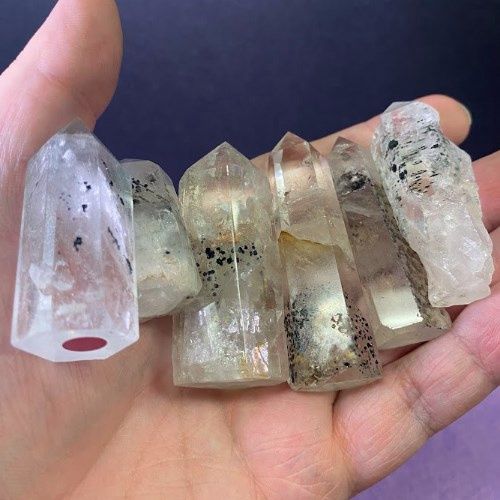SALE! Black Friday, Small Business Saturday and Cyber Monday Event Save 25% off everything! 11-28 to 12-1
Quartz w/ Biotite Black Mica + Garden Tower 2" - 3.5"
SKU 59579
$8.99
In stock: 2 available
1
Product Details
Quartz w/ Biotite Black Mica + Garden Tower 2" - 3.5"
Mineral Information:
Quartz with mica refers to a rock or mineral assemblage that contains both quartz and mica minerals. Quartz is a common mineral composed of silicon and oxygen, while mica is a group of minerals that have a layered structure and belong to the larger silicate mineral family.
Mica minerals, such as muscovite and biotite, are known for their characteristic sheet-like or flaky appearance. They are usually light-colored, although biotite can be darker due to its higher iron content. Mica minerals have excellent cleavage, which means they can be easily split into thin, flexible sheets.
When quartz and mica occur together in a rock, it forms a type of rock called quartz-mica rock or, more specifically, a quartz-mica schist. Schist is a metamorphic rock that has undergone moderate to high levels of heat and pressure, resulting in the development of a foliated texture and the alignment of mineral grains.
The exact composition and appearance of quartz with mica can vary depending on the specific minerals present, the ratio of quartz to mica minerals, and the geological processes involved in its formation. In quartz-mica rocks, quartz often forms the predominant framework of the rock, with mica occurring as thin, parallel layers or flakes within the quartz matrix.
The presence of mica in quartz-mica rocks can add visual interest, as the reflective and shimmering nature of mica flakes creates a distinct sparkle or sheen. The color of the rock can range from light to dark, depending on the relative amounts of quartz and mica minerals present.
Quartz with mica is often used as a decorative stone, as the combination of quartz and mica minerals gives it a unique texture and appearance. It can be used in various applications such as countertops, tiles, flooring, and as a component in ornamental objects or jewelry.
Metaphysical Meaning:
Quartz is known for its ability to amplify energy and intentions. It is believed to enhance clarity of thought, spiritual growth, and the manifestation of goals. The presence of mica in quartz may add a reflective and shimmering quality, enhancing the amplifying properties of quartz.
Mica is often associated with reflection, self-awareness, and self-reflection. The reflective nature of mica flakes may symbolize the importance of introspection, introspective journeys, and understanding oneself on a deeper level. Quartz with mica may aid in fostering self-awareness and encourage contemplation.
Mica is also associated with enhancing intuition, psychic abilities, and spiritual insights. It may be used to facilitate a deeper connection to one's intuition and higher wisdom. The combination of quartz's amplifying properties and mica's reflective nature may support the development and utilization of psychic abilities.
Mineral Care:
Quartz with mica, specifically referring to a rock or mineral assemblage containing both quartz and mica minerals, can vary in terms of its fragility depending on several factors.
Quartz itself is a relatively durable and hard mineral, ranking 7 on the Mohs scale of mineral hardness. It is composed of tightly bonded silicon and oxygen atoms, giving it strength and resistance to scratching and fracturing. Quartz is known for its durability and is widely used in various applications, including countertops and jewelry.
Mica minerals, on the other hand, are softer and more delicate compared to quartz. Muscovite mica typically has a hardness of 2-2.5 on the Mohs scale, while biotite mica ranges from 2.5 to 3.5. These values indicate that mica minerals are more prone to scratching and breakage compared to quartz.
When quartz and mica occur together in a rock, the fragility of the quartz with mica is influenced by the interplay between these two minerals. Mica, being softer, can potentially break or flake off from the quartz matrix if subjected to sufficient pressure or impact. The larger and more prominent the mica flakes within the rock, the greater the potential fragility.
Moreover, the texture and structure of the rock can also influence its fragility. If the mica flakes are loosely bound within the quartz matrix or if the rock contains fractures or weaknesses, it may be more susceptible to breakage or crumbling.
It's important to handle quartz with mica with care to avoid unintentional damage. Avoid exposing it to sharp impacts, extreme temperature changes, or rough handling that could potentially dislodge or fracture the mica flakes. Storing the specimen in a protective pouch or wrapping it in a soft cloth can help prevent accidental damage.
Overall, while quartz with mica can be relatively durable due to the presence of quartz, the fragility of mica minerals should be considered when handling or working with specimens containing both minerals.
Disclaimer:
No information here is intended to diagnose, treat or cure ailments or afflictions of any kind. One should always consult a medical professional if a serious issue presents itself.
Save this product for later
Quartz w/ Biotite Black Mica + Garden Tower 2" - 3.5"
Display prices in:USD

